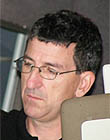|
Author
|
Topic: Lamphouse wire size and type
|
|
|
|
|
John Hawkinson
Film God

Posts: 2273
From: Cambridge, MA, USA
Registered: Feb 2002
|
 posted 01-02-2010 11:42 AM
posted 01-02-2010 11:42 AM




"Ask an electrician."
Size of the cable should be determined by the maximum allowable voltage drop you are willing to tolerate, which should be primarily dictated by length of the run, but also has to do with what your rectifiers can support. Length (and current) dictates voltage drop, which dictates the wire gauge. Look this up in the NEC, or your favorite table.
For short runs that flex, welding cable is expensive but nice. For long runs (unlikely in modern booths, but possible), THHN is cheap and reasonable.
(Hmm, I see Steve posted while I was typing. Well, I'll post this anyway...)
--jhawk
| IP: Logged
|
|
|
|
|
|
|
|
|
|
|
|
|
|
|
|
|
|
|
|
|
|
|
|
|
|

 Home
Home
 Products
Products
 Store
Store
 Forum
Forum
 Warehouse
Warehouse
 Contact Us
Contact Us




 Printer-friendly view of this topic
Printer-friendly view of this topic
















